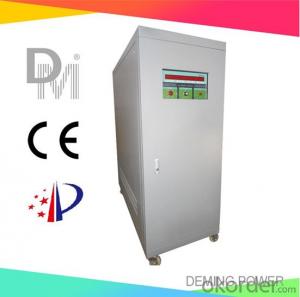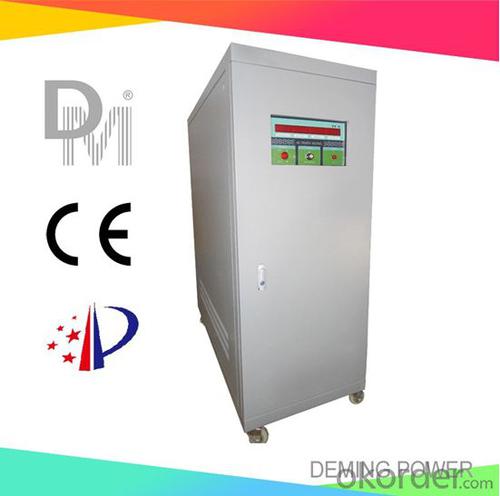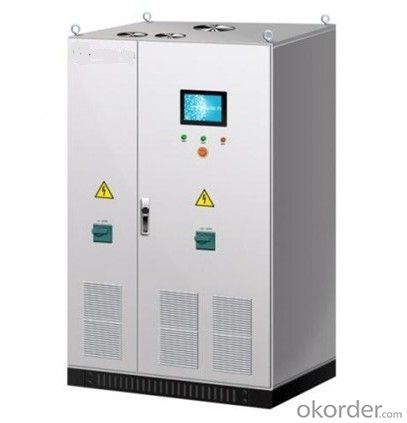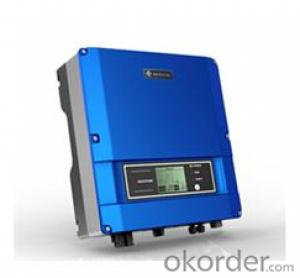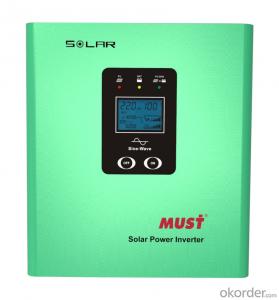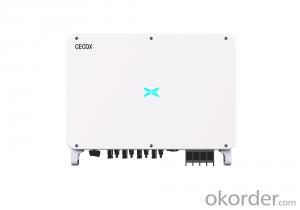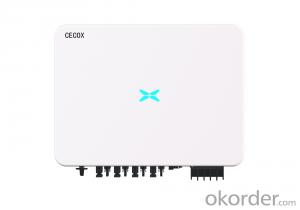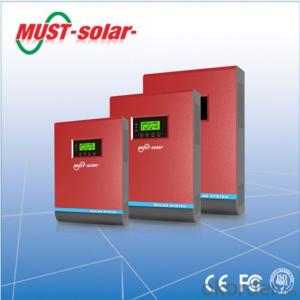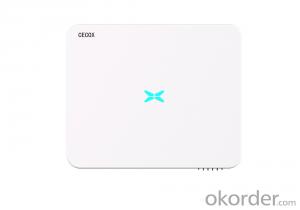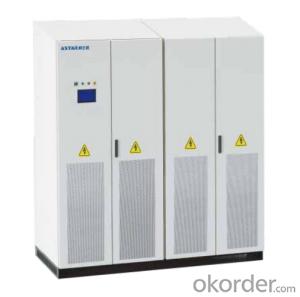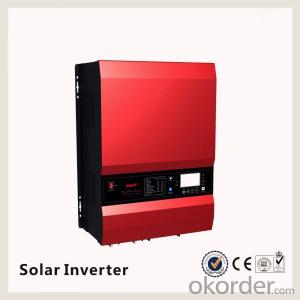Solar Inverter 12v 50kw Off Grid Three Phase Photovoltaic Inverter
- Loading Port:
- China main port
- Payment Terms:
- TT or LC
- Min Order Qty:
- 50000 watt
- Supply Capability:
- 3000000 watt/month
OKorder Service Pledge
OKorder Financial Service
You Might Also Like
1. Structure of Photovoltaic Inverter 50KW Off Grid Three Phase
A solar inverter, or PV inverter, or Solar converter, converts the variable direct current (DC) output of a photovoltaic (PV) solar panel into a
utility frequency alternating current (AC) that can be fed into a commercial electrical grid or used by a local, off-grid electrical network. It is
a critical BOS–component in a photovoltaic system, allowing the use of ordinary AC-powered equipment. Solar inverters have special
functions adapted for use with photovoltaic arrays, including maximum power point tracking and anti-islanding protection.
2. Main Features of Photovoltaic Inverter 50KW Off Grid Three Phase
• using IGBT from Mitsubishi company as the power components
•using American ATEMEL company microprocessor as figure controller
• perfect protection and warning functions
• circuit frame compact,Max. Efficiency≥94%
• with wide input voltage range
• RS232/485 communication,multi communication interface can be selected
•big-screen English LCD, perfect display, interface-friendly
3. Photovoltaic Inverter 50KW Off Grid Three Phase Images
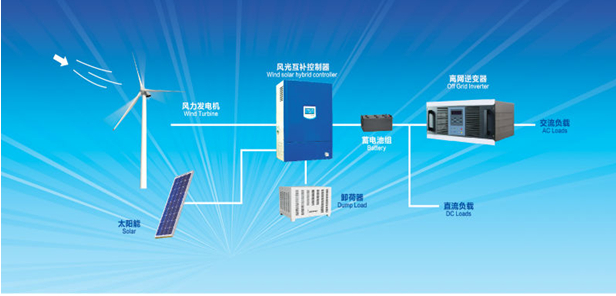
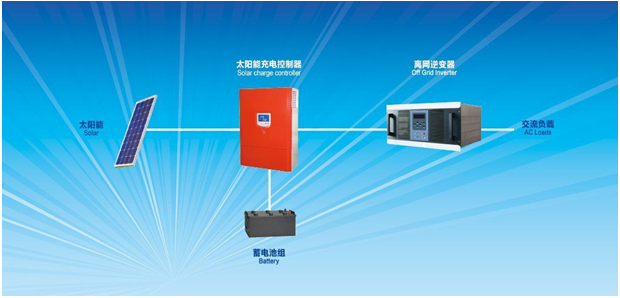
4. Photovoltaic Inverter 50KW Off Grid Three Phase Specification
窗体顶端 50KVA off grid three phase inverter technical parameters 窗体底端 | |||
Type | ND220-50KS | ND380-50KS | |
DC input | Input rated voltage | 220 VDC | 380 VDC |
Input rated current | 227 A | 132 A | |
Input DC voltage range | 180-300 VDC | 300-490VDC | |
| Allow input voltage range | 220 VAC / 380 VAC / 400 VAC ± 15% VAC | |
AC input | Input rated current | 139A / 76A / 72.5A | |
| Bypass transfer time | ≤4 ms | |
AC output | Rated capacity | 50KVA | |
Output rated power | 40KW | ||
Output rated voltage and frequency | 220 VAC / 380 VAC / 400 VAC,50Hz / 60Hz | ||
Output rated current | 139A / 76A / 72.5A | ||
Output voltage accuracy | 220 VAC / 380 VAC / 400 VAC ± 2% | ||
Output frequency accuracy | 50Hz / 60Hz ±0.05% | ||
Waveform distortion (THD). (Linear load) | ≤3% | ||
Dynamic response time (Load 0←→100%) | 2ms | ||
Power factor (PF) | 0.8 | ||
Overload capacity | 120%,3 minutes,150%,10 second | ||
Crest factor (CF) | 3:01 | ||
Inverter efficiency | 94% | ||
Working Environment | Dielectric strength | 1500VAC,1minute | |
Noise (1m) | ≤50dB | ||
Ambient temperature | -10℃~+50℃ | ||
Humidity | 0~90%,No condensation | ||
Altitude | ≤5000 m | ||
Production function | Input reverse protection, input under-voltage protection, output overload protection, output short circuit protection, thermal protection | ||
5. FAQ of Photovoltaic Inverter 50KW Off Grid Three Phase
Q1:Can we visit your factory?
A1:Sure,welcome at any time,seeing is believing.
Q2:Which payment terms can you accept?
A2:T/T,L/C,Moneygram,Paypal are available for us.
- Q: What is the role of a grid connection feature in a solar inverter?
- The role of a grid connection feature in a solar inverter is to allow the solar power system to connect and interact with the electrical grid. This feature enables the solar inverter to convert the direct current (DC) produced by the solar panels into alternating current (AC) that is compatible with the electrical grid. It ensures that excess solar energy can be fed back into the grid, allowing the system owner to receive credit or payments for the electricity generated. Additionally, the grid connection feature allows the system to draw power from the grid when solar energy is insufficient, ensuring a reliable and continuous power supply.
- Q: Can a solar inverter be used with different types of grounding systems?
- Yes, a solar inverter can be used with different types of grounding systems. Solar inverters are designed to be flexible and adaptable to various electrical systems and grounding configurations. They can be used with grounded, ungrounded, or impedance grounded systems, allowing for compatibility across different types of grounding systems.
- Q: How does a solar inverter handle voltage drop in long cable runs?
- A solar inverter compensates for voltage drop in long cable runs by boosting the voltage to ensure efficient power transmission.
- Q: What is the lifespan of the capacitors in a solar inverter?
- The lifespan of capacitors in a solar inverter can vary depending on several factors such as the quality of the capacitors, the operating conditions, and the overall design of the inverter. However, on average, high-quality capacitors in a well-designed solar inverter can have a lifespan of around 10 to 15 years. Regular maintenance and proper usage can help extend the lifespan of the capacitors in a solar inverter.
- Q: How does a solar inverter handle voltage and frequency variations caused by grid disturbances?
- A solar inverter is designed to handle voltage and frequency variations caused by grid disturbances by regulating and stabilizing the incoming AC power from the grid. It constantly monitors the voltage and frequency levels of the grid and adjusts its internal components accordingly to ensure that the power being generated by the solar panels is synchronized with the grid. In cases of voltage or frequency deviations, the inverter employs advanced control algorithms to rectify the imbalances and maintain a steady flow of power to the grid. This helps to protect the electrical appliances and equipment connected to the grid from potential damage and ensures the stability and reliability of the overall power system.
- Q: What is the function of a solar inverter in a solar power system?
- The function of a solar inverter in a solar power system is to convert the direct current (DC) electricity generated by the solar panels into alternating current (AC) electricity that can be used to power household appliances and feed into the electrical grid.
- Q: Can a solar inverter be used with a time-of-use electricity tariff?
- Yes, a solar inverter can be used with a time-of-use electricity tariff. Time-of-use electricity tariffs typically involve different rates for electricity consumption based on the time of day. A solar inverter can be programmed to produce and export excess solar energy during peak times when electricity rates are higher, and import energy from the grid during off-peak times when rates are lower. This allows users to optimize their energy consumption and potentially save on electricity costs.
- Q: Can a solar inverter be used with a net metering system?
- Yes, a solar inverter can be used with a net metering system. A solar inverter is an essential component of a solar power system as it converts the direct current (DC) generated by solar panels into usable alternating current (AC) electricity. Net metering allows for the excess electricity produced by the solar panels to be fed back into the grid, resulting in credit or compensation from the utility company. The solar inverter facilitates this process by ensuring that the electricity generated by the solar panels is synchronized with the grid, allowing for seamless integration and net metering.
- Q: How does a solar inverter protect against voltage fluctuations?
- A solar inverter protects against voltage fluctuations by continuously monitoring and regulating the electrical output from the solar panels. It adjusts the voltage and frequency of the direct current (DC) generated by the panels to match the utility grid's alternating current (AC) voltage requirements, ensuring a stable and consistent power supply. Additionally, solar inverters have built-in protection mechanisms such as surge suppression and overvoltage/undervoltage detection, which safeguard the system from voltage spikes or drops, preventing any potential damage to the solar panels or electrical devices.
- Q: How do you calculate the maximum power point voltage for a solar inverter?
- To calculate the maximum power point voltage for a solar inverter, you need to consider the voltage at which the solar panel generates the highest power output. This can be determined by using the voltage-current (V-I) curve of the solar panel and finding the point where the product of voltage and current is maximum. By analyzing this curve, the maximum power point voltage can be identified, which is crucial for optimizing the performance of a solar inverter.
Send your message to us
Solar Inverter 12v 50kw Off Grid Three Phase Photovoltaic Inverter
- Loading Port:
- China main port
- Payment Terms:
- TT or LC
- Min Order Qty:
- 50000 watt
- Supply Capability:
- 3000000 watt/month
OKorder Service Pledge
OKorder Financial Service
Similar products
Hot products
Hot Searches
Related keywords
